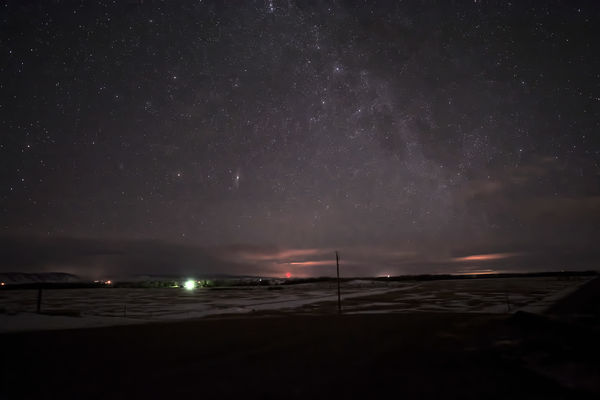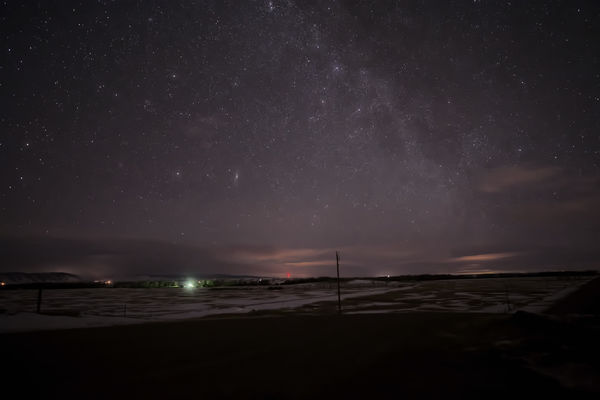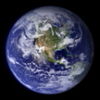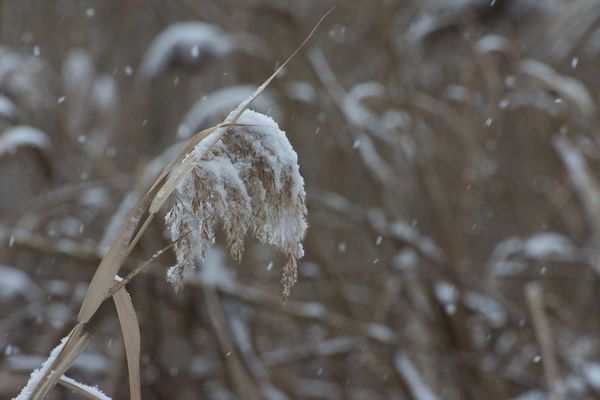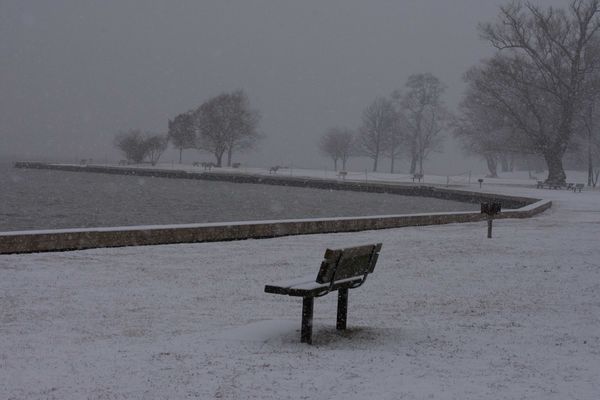Eliminating star trails
Feb 1, 2017 15:59:45 #
Using the shutter speed and 500 rule (some say 600) I should be able to get sharp stars at 20 sec with a 16mm lens on a 1.5 cropped sensor. I have attached two photos taken the same night at 20 sec and 10 sec. The 20 sec has noticeable star trails, at 10 sec the stars are somewhat oblong. It is only at 8sec that they become dots.
Data: Nikon D7100, Samyang 16mm f2.0, tripod mount, remote shutter release. Both shot at ISO 3200 and f2.0, -.3EV (forgot to reset!), one at 10 sec and the other shot at 20 sec about 10 min apart. My question, am I doing something wrong or do I live with 10 sec to get sharp stars and suffer along with low exposure?
Thanks for any help.
Data: Nikon D7100, Samyang 16mm f2.0, tripod mount, remote shutter release. Both shot at ISO 3200 and f2.0, -.3EV (forgot to reset!), one at 10 sec and the other shot at 20 sec about 10 min apart. My question, am I doing something wrong or do I live with 10 sec to get sharp stars and suffer along with low exposure?
Thanks for any help.
Feb 1, 2017 16:49:20 #
If your camera can do double or multiple exposures, you may be able to get the equivalent of longer exposure in several short ones, which the camera will average together into one image. You could try two 8 second exposures.
Feb 1, 2017 17:06:00 #
When I download both images and look at them on my 24" screen, there is no noticeable trail with either image unless I zoom in. If you're going to print the shot (by the way, they are beautiful) I can't image anybody will notice trails even if it's a 13 x 19 print.
Feb 1, 2017 17:08:06 #
Thank you, Charles for your quick response. I generally shoot in raw and could do multiple shots and stack like the pros on this site. That said, I am pushing my system as hard as I can in an effort to do a combo of sky and land in one shot. I have gotten some good results but it seems like I need 20 - 30 sec to get enough detail in the foreground. This also saves me having to merge in GIMP (a real pain!). Perhaps I am chasing an impossible rainbow but I thought I would get some input.
Feb 1, 2017 17:18:23 #
Shootist wrote:
Using the shutter speed and 500 rule (some say 600... (show quote)
The 500 Rule is more a guide or starting point than a rule so don't worry there and there are other factors that can attribute to star trails like weather, etc.
And I know you wrote your specs, but the exif data has been removed so I'd ask that you check it again to make sure your camera didn't program shift.
Additionally think about the tripod and camera setup. Was it cold or was there excessive atmosphere? Did you use mirror lockup or live view, and did you brace the tripod and or camera with weight to remove any shake? Have you used the tripod in daylight for that long without shake?
I've been here and like I said the 500 is a starting point from there it's up to you! S-
Feb 1, 2017 17:19:01 #
Machinedoc. Thanks! I must admit that I am a hardcore pixelpeeper. This thing called retirement is giving me too much free time to do engage in non profitable endeavors like obsessing over non important details.
It is winter here with sub freezing temp, lots of icy roads, high winds and lots of high haze. You have reminded me that it is time ignore the small stuff and get out and shoot more.
It is winter here with sub freezing temp, lots of icy roads, high winds and lots of high haze. You have reminded me that it is time ignore the small stuff and get out and shoot more.
Feb 1, 2017 17:22:38 #
Shootist wrote:
... This also saves me having to merge in GIMP (a real pain!). ...
I like these two -
Startrails http://www.startrails.de/html/software.html
StarStaX http://www.markus-enzweiler.de/software/software.html
Feb 1, 2017 17:27:16 #
Retirement is a wonderful thing ... was "out there" yesterday ... just keep pushing the shutter release, sit back and enjoy the result!
Feb 1, 2017 17:47:47 #
St3vM3
Good thoughts. The specs are good. I was using a car window mount, it was cold, it was somewhat windy but I tried to shoot when wind fell off, did use MLU and in camera dark frame subtraction, it was a somewhat murky atmosphere. The samples selected were from about 12-15 shots and all show about the same star trails.
I did not realize that temp and atmosphere affected star trails so you have given me some factors to watch out for.
Good thoughts. The specs are good. I was using a car window mount, it was cold, it was somewhat windy but I tried to shoot when wind fell off, did use MLU and in camera dark frame subtraction, it was a somewhat murky atmosphere. The samples selected were from about 12-15 shots and all show about the same star trails.
I did not realize that temp and atmosphere affected star trails so you have given me some factors to watch out for.
Feb 1, 2017 17:57:21 #
Shootist wrote:
St3vM3
Good thoughts. The specs are good. I was using a car window mount, it was cold, it was somewhat windy but I tried to shoot when wind fell off, did use MLU and in camera dark frame subtraction, it was a somewhat murky atmosphere. The samples selected were from about 12-15 shots and all show about the same star trails.
I did not realize that temp and atmosphere affected star trails so you have given me some factors to watch out for.
Good thoughts. The specs are good. I was using a car window mount, it was cold, it was somewhat windy but I tried to shoot when wind fell off, did use MLU and in camera dark frame subtraction, it was a somewhat murky atmosphere. The samples selected were from about 12-15 shots and all show about the same star trails.
I did not realize that temp and atmosphere affected star trails so you have given me some factors to watch out for.
It sounds like you have it nailed, but I have to ask, was the car running to keep you warm, and even worse could you have moved?
I've learned to hang a weighted bag from the tripod hook and sometimes place one over the camera and lens. I also use mirror lockup or live view and have pretty good luck avoiding the shakes. A good test for cold weather is to look at the moon where the rings mean more atmospheric particles than normal. It's the same problem you have trying to get a good shot of the moon at the horizon where the trick is to shoot straight up with less murk.
I haven't used the software I suggested, but one of them has a good forum and an amazing customer service. I emailed them with something and was shocked at how helpful they were. The real trick with night photography though is to try, try, and try again. It's amazing when it works! Cheers, S-
Feb 1, 2017 18:02:31 #
Thanks machinedoc, nice pix. You are right, its like golf. Practicing your swing is important but it's secondary to getting out and playing the game.
Feb 1, 2017 18:18:55 #
St3vM3. Car was off, tried not to move. Interesting that star trails were all same direction in all photos. Good advice on weighted tripod and lens.
I was suprised at the number of nights here that have excess moisture in the air. We are at 7,200 ft in an area classified as semi desert. I have often shot photos at below 0 F and had high and mid level haze lit by small towns 30 miles away.
I was suprised at the number of nights here that have excess moisture in the air. We are at 7,200 ft in an area classified as semi desert. I have often shot photos at below 0 F and had high and mid level haze lit by small towns 30 miles away.
Feb 1, 2017 20:31:56 #
Shootist wrote:
St3vM3. Car was off, tried not to move. Interesting that star trails were all same direction in all photos. Good advice on weighted tripod and lens.
I was suprised at the number of nights here that have excess moisture in the air. We are at 7,200 ft in an area classified as semi desert. I have often shot photos at below 0 F and had high and mid level haze lit by small towns 30 miles away.
I was suprised at the number of nights here that have excess moisture in the air. We are at 7,200 ft in an area classified as semi desert. I have often shot photos at below 0 F and had high and mid level haze lit by small towns 30 miles away.
I have the same problem here and am told my best solutions are to shoot from a mountain top or straight up. Keep working at it and you'll never be sorry! S-
Feb 1, 2017 20:39:36 #
I looked at the fixed objects in the two pics and they don't show any sign of motion artifact (at least to my eyes with my reading glasses on) so I think that the camera was really steady. I really went at this from a physical point of view - the earth rotates (at the equator) at a velocity of about 450 miles/second...don't worry, I didn't calculate it at your location...so at the equator, with a 10 second exposure (easy math) the earth would have rotated about 4500 miles...even though the stars are far away, there still might be some trail if you look really hard. Doesn't matter though, you pic a 10 secs is stunning...and no light pollution...that's a luxury I don't have some 40 miles north of the Big Apple!
Feb 1, 2017 20:44:49 #
I invite you to drop-by the UHH section Astronomical Photography Forum at http://www.uglyhedgehog.com/s-109-1.html
These guys know there stuff, and are quite friendly. They speak from experience.
These guys know there stuff, and are quite friendly. They speak from experience.
If you want to reply, then register here. Registration is free and your account is created instantly, so you can post right away.

